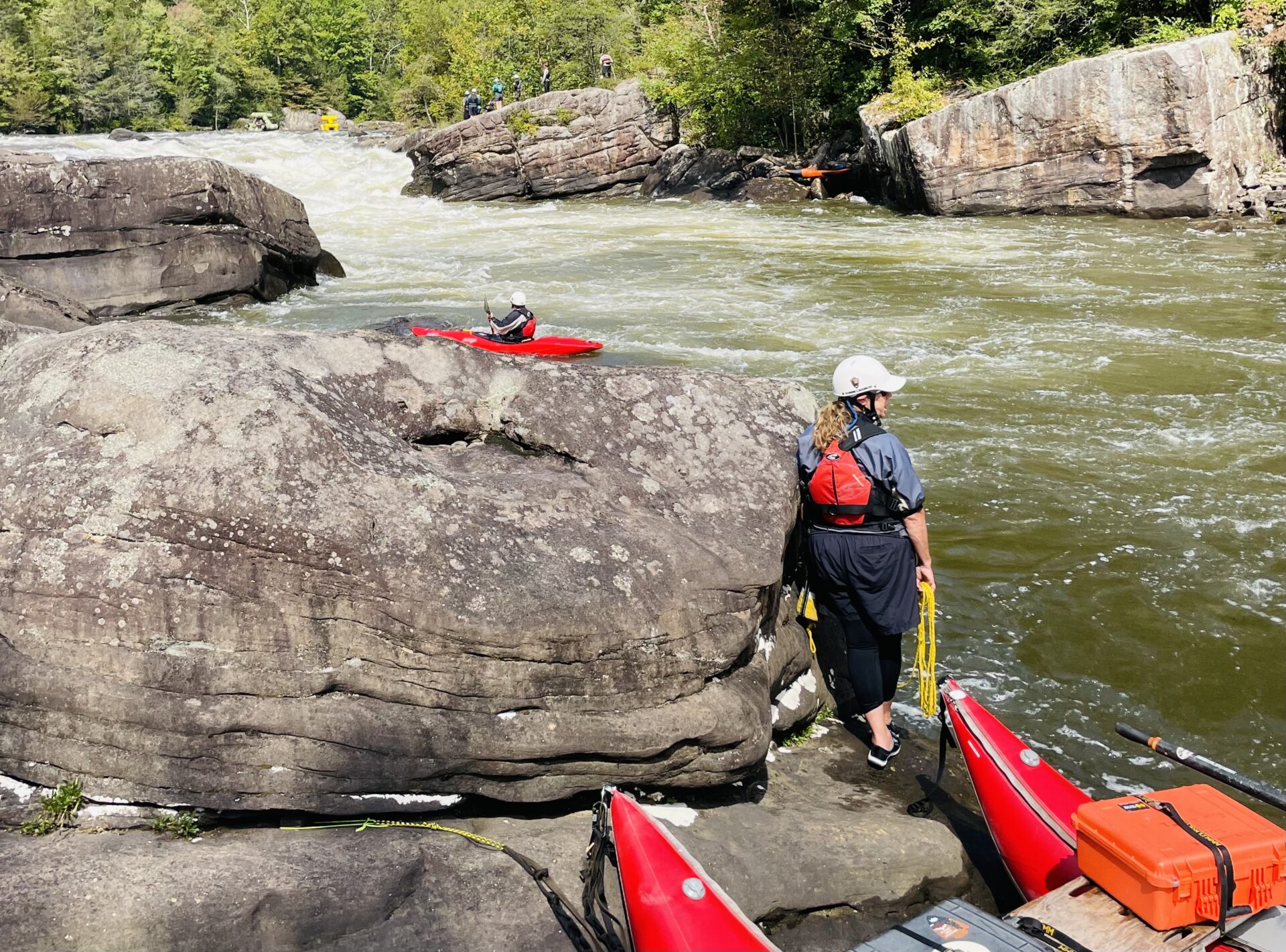As summer winds down, tens of thousands of whitewater rafters and kayakers from all over the country begin their migration to West Virginia. They are here for the Gauley River — which normally only has navigable flows during the fall.
The fall recreational flows are part of a planned effort of water releases in the fall to draw down Summersville Lake and support whitewater rafting and kayaking.
Companies offer guided trips down the river for customers without expert whitewater skills. However, most of the boats on the river are private boaters or individuals who own their own equipment and have the professional knowledge and abilities to navigate the river.
Credit: Briana Heaney/West Virginia Public Broadcasting
The National Park Service said this year they have seen more private boaters than ever.
Matt McQueen is a park ranger. The Gauley has recreational releases two to four days a week during its six week season. On those days he is paddling down the river in his red kayak alongside a red cataraft operated by another park ranger — Kathy Zerkle.
Chromatic Currents
The colors on the hills change from a bright green in the beginning of the season to vibrant yellows, reds and oranges in the late season. The landscape is interrupted by the bright primary-colored boats, tutus, sequined shirts and glittered faces, all headed downstream from where the river begins at Summersville Dam.
“A lot of different colors, a lot of plastic on the water, a lot of smiling faces, a lot of glitter, a lot of lipstick,” McQueen said. “There’s definitely a whole culture involved in the whitewater industry that is kind of unique, for sure.”
Headed East To West Virginia
The colorful and glittery private boaters gather on this river from all over the country.
Melissa Clivio-Wentrup is one of those sparkling travelers. She started guiding on the river this summer in her home state of Montana.
“A lot of our senior guides had spoken a big game about the Gauley. I had heard this name kind of floating around in the parking lot since I had gotten there,” Clivio-Wentrup said.
Credit: Briana Heaney/West Virginia Public Broadcasting
Kevin Fitch agreed. He has been guiding for nine years in Colorado and has come to West Virginia for the past few falls to work and play on the river.
Credit: Briana Heaney/West Virginia Public Broadcasting
The Big Pushy Water Of The Gauley
The rafters said they come here because of how massive the whitewater is. The “White Water Guide Book” said the Gauley is the best river for a single day trip. The river has many of the qualities that create big whitewater: a steep descent, lots of water and lots of obstacles.
During the release, it runs at a minimum of 2,800 cubic feet per second, or CFS. A cubic foot of water is about the size of a basketball. If there was a line going across the river, every second 2,800 basketballs worth of water would cross it during the recreational release.
“Because of the style of the Gauley, 2,800 ends up being a large amount of water for a relatively small river,” Fitch said.
Fitch said the combination of those features make the waves reminiscent of a big ocean swell.
“You’re looking ten feet above you, at the crest of the wave. Your only perspective, your only visual at that point, is the water around you and the trees that poke about above them,” Fitch said.
Rating The River
Those waves, rocks and water all factor into a whitewater classification system that rates rapids from 1-6 on level of difficulty. Park Ranger McQueen said that you can think of class one as a choppy day on a lake, and class six as a nearly impossible run.
“Class five is more of an expert level where significant hazards are present,” he said. “Navigation and the route are not always easily apparent. There are some solid navigational skills that need to be required to get through and strengthen, strength for sure.”
The Gauley has five class five rapids: Iron Curtain, Pillow, Lost Paddle, Iron Ring and Sweets Falls.
The Sounds Of White Water
The chance of ending up in the water is higher in those rapids, McQueen said. He believes in the river mantra that a boater is always just in between swims.
“No matter how good, or skilled, or experienced you are as a whitewater paddler, eventually something is going to happen where you’re gonna find yourself in the water, taking a swim,” he said.
That’s why the park service is out there kayaking below rapids, or standing on rocks with throw bags.
Boaters perched on rocks below some of the rapids, boats tied to trees, watching other rafters and kayakers paddle the rapid. When a raft or kayak has made a few mistakes and flipping or swimming look likely, cheers erupt from bystanders.
“Cheers generally mean that you have messed up your line. Cheers generally mean that somebody is going in the water,” Fitch said.
Credit: Briana Heaney/West Virginia Public Broadcasting
However, he said that if the swimmers are in a dangerous position then the rock-perched boaters immediately take action.
“What is absolutely epic about those times is everyone will cheer as things are going wrong,” Fitch said. “But if things end up going weird, the cheers immediately stop. And the concern for the individual and getting them out of the scenario that they’re in becomes paramount. And that is one of the aspects of a phenomenal community here.”
The Gauley River usually gets 20,000 to 30,000 visitors each season. Rangers are predicting that the numbers this year could be their highest yet.
The 2023 Gauley season started Sept. 8 and will end on Oct. 22.
